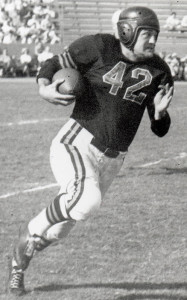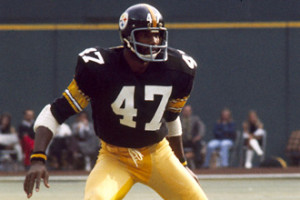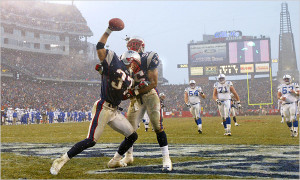Nine men have thrown for 4,900 passing yards in a season. Seven of them did so in either 2011 or 2012. How did we get here? The NFL has turned into a pass-heavy league, but these changes didn’t happen overnight: a series of rules changes since the berth of the league have promoted the pass-happy environment we see today. The first ever playoff game came in 1932, pitting the Chicago Bears against the Portsmouth Spartans, predecessors of today’s Detroit Lions. The game was scoreless until the fourth quarter, when Bronko Nagurski threw a controversial pass to Red Grange for the game-winning touchdown. The pass was controversial because in 1932, a player needed to be at least five yards behind the line of scrimmage in order to be eligible to pass. The league eliminated the rule after the game [1]There must be an inverse relationship between passing prowess and rule volatility, since it took the NFL twelve years to get rid of the Tuck Rule., allowing quarterbacks and other passers to be able to pass from anywhere behind the of scrimmage.
In 1934, a slimmer and more aerodynamic football was introduced to make life easier for quarterbacks. In the 1940s, most teams switched from the single-wing to the T-Formation, which placed the quarterback in the center of the offense and helped promote the passing game. Sammy Baugh in Washington and Sid Luckman in Chicago dominated the league, and the Redskins or Bears won the title every year from 1940 to 1943. During World War II, every franchise was playing with depleted rosters, so the league experimented with a rule change that would permit liberal substitutions. Finally, in 1950, the league finally decided to go with free substitution rules on a permanent basis. As pro football historian Sean Lahman explains:
For the NFL’s first three decades, versatility was the most important trait for a player. Your starting quarterback had to be quick enough to play safety, your running backs tough enough to play linebacker. The downside to this approach was that a player with one specific skill – say blazing speed – might not be enough of an all-around player to crack the starting lineup. With free substitution legalized, specialization became the norm…. Free substitution helped the passing game immensely because it allowed coaches to use quick players at offensive end who weren’t big enough to play defense. Their speed could be used as a weapon, and many teams moved to formations that featured three ends and just two backs.
The changes produced immediate results, and by 1954, the passing game had exploded. For the first time in league history, the league average completion percentage topped fifty-percent, and the average pass attempt gained 7.2 yards. By point of reference, teams averaged 7.1 yards per pass attempt in 2012.
Looking at just yards per attempt, one would think that NFL teams aren’t more effective at passing now than they were in the middle of the 1950s. But the next stage in the aerial evolution didn’t make the passing game more productive: it made it more consistent. From 1950 to 1978, the league average sack rate hovered around 8.3 percent. Since then, the sack rate has steadily declined, and dropped to just 6.1% since 2007. We’ve seen similar declines in interception rate and steady increases in completion percentage. Woody Hayes famously said that when you pass, three things can happen, and two of them are bad. In reality, four things can happen, and three of them are bad (sacks, interceptions, and incomplete passes). That’s why the most notable change over the last 60 years of football is that when teams pass, there have been fewer and fewer bad things happening.
And while free substitution was helping out offenses, defenses were becoming more innovative. Tom Landry dropped a fifth lineman into coverage to bring his 4-3 defense to the NFL, a direct response to the improvements in the passing game. In response, teams saw slight upticks in completion percentage and threw fewer interceptions — by throwing shorter passes (yards per completion began to steadily decline). Teams like the late ’50s 49ers began using West Coast Offense principles to make the pass a less risky alternative, but offenses eventually found themselves up against a glass ceiling. By the middle of the 1970s, defenses had begun dominating again. As a result, NFL coaches recommitted to the running game. In 1977, teams averaged just 25 passes per game (versus 29.4 in 1954 and 34.7 last year) and completed only 51.3 percent of passes. [2]The NFL also saw a modern record 37.4 runs per team game that season. That low completion rate existed despite the presence of more horizontal passing offenses [3]Yards per completion dropped from 14.2 in ’54 to 12.7 in ’75, ’76 and ’77, leading to a puny 6.5 yards per pass attempt average. The Falcons, Rams, and Broncos all held opponents under 150 points that season, and the league had seen enough. Before the next season would be played, the NFL enacted the biggest rules changes since free substitution occurred. Pete Rozelle stated the desired intent unambiguously: “more long-gainer plays, more passes, more scoring.”
From 1970 to 1977, teams averaged 5.3 interceptions per 100 passes; that average steadily dropped over the next 15 years, eventually falling by two full interceptions to 3.3 in 1993. At the same time, yards per completion dropped and completion percentage rose, further reflecting the desire of teams to complete shorter passes instead of waiting for big plays. By 1992, yards per completion dropped below 12.0 for the first time in league history, and it has remained that way nearly every year since. Pass attempts steadily increased, too, and teams averaged over 30 passes per game every year in the ’80s.
But while teams started passing more frequently, completing more passes, throwing fewer interceptions and getting sacked less frequently, the yards per attempt average for the league has continued to hover around 7.0. Meanwhile, in the ten year period from 1956 to 1965, NFL [4]By NFL, I mean NFL, and not the combined NFL/AFL statistics. teams averaged 7.4 yards per attempt. Even accounting for sacks, net yards per attempt from ’56 to ’65 was 6.1, while from 1979 to 2003, the league average net yards per pass ratio hovered around 5.9. It helped that Johnny Unitas accounted for 7.3% of all passes thrown during that decade, but that was a much passer-friendly era than many remember. The evolution of the league has been far from linear, and that period stands out as an efficient but very different era. From ’56 to ’65, teams completed 51% of their passes but averaged 14.4 yards per completion, which are Tim Tebow numbers. Over the last ten seasons, the average has been 60.3% and 11.5 yards per completion, while pass attempts per team game have risen from 26.3 to 33.0.
Three more changes in the past decade have helped send passing numbers through the roof. Following the 2003 playoffs, the league decided to more strictly enforce rules regarding illegal contact, pass interference and defensive holding. After Carson Palmer and Tom Brady suffered serious, high-profile knee injuries, the NFL enacted several rules to restrict the actions of defensive pass rushers. Rules have also been enacted to prevent concussions, including a prohibition on hitting defenseless receivers and launching and leading with a helment or shoulder into the opponent’s helment or neck area. As a result, the passing game is more wide open than ever. Combined with the increased prevalence of the shotgun formation and the incorporation of spread elements into traditional offenses, and teams have been passing more frequently and more effectively than ever before. Three seasons in NFL history have seen at least 34 passes per team game: 1995, 2011, and 2012. And quarterbacks are staying healthier than ever, too.In the ’50s and ’60s, teams viewed the pass as a big play option. You expected to be intercepted and sacked, but considered that simply a cost of doing business when teams averaged over 14 yards per completion. But the various rules changes have now turned the pass into a normal way to run your offense. Even when the passing game peaked in the ’50s and ’60s, the league average pass to run ratio barely topped fifty-percent. That ratio has been steadily rising following the ’78 rules changes (the ratio dipped as low as 42% in 1977), and teams passed on 57.7% of all pass plays in 2012.
The ratio of team passing to rushing first downs has following a similar pattern. After dropping below 50% during various points of the dead ball era of the ’70s, more and more teams are gaining first downs via the pass. 2010 was the highest mark in football history, when teams gained first downs 65.6% of the time through the air; then it jumped to 65.9% in 2011, and finally 66.4% last season. The latest revolution seems to involve tempo, as we say with Manning last night, and as we’ll likely see with Chip Kelly and the Eagles. Within the next few years, I think we’ll see that first down ratio creep even closer to 70%.
References
| ↑1 | There must be an inverse relationship between passing prowess and rule volatility, since it took the NFL twelve years to get rid of the Tuck Rule. |
|---|---|
| ↑2 | The NFL also saw a modern record 37.4 runs per team game that season. |
| ↑3 | Yards per completion dropped from 14.2 in ’54 to 12.7 in ’75, ’76 and ’77 |
| ↑4 | By NFL, I mean NFL, and not the combined NFL/AFL statistics. |



